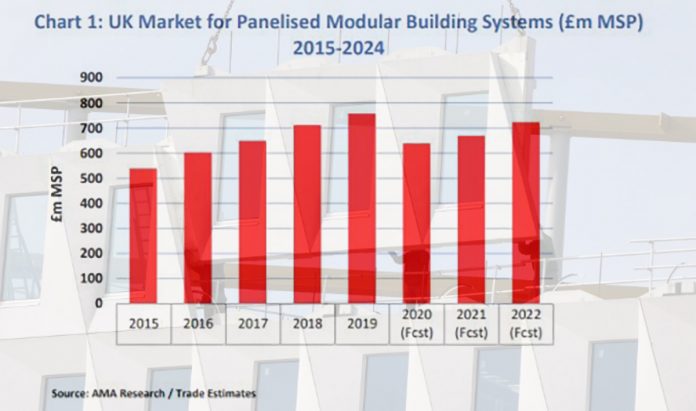![]()
The panelised modular building systems market in the UK was worth £753m in 2019. It is worth noting that due to the impact of the Coronavirus pandemic, AMA Research are forecasting that contractors’ output is expected to be down by 20% in 2020. As a result of this downward turn, the panelised modular building systems market will also experience a decline in 2020 as the two are not mutually exclusive. This will result in a drop of 15% decreasing the market value to £636m.
Off-site manufacturing, such as panelised modular building systems may recover faster as it is more conducive to Covid-19 safety measures such as social distancing. The adaptation of the working environment has been an easier transition than a traditional construction setting, due to it being less labour intensive and requiring fewer personnel on site. With all construction work carried out on a production line, activity can be planned and monitored to ensure that social distancing is adhered to.
More importantly there is now a strong likelihood of an increase in the use of volumetric and other types of off-site construction method to help meet the chronic housing shortage, cope with the lack of traditional construction skills within the construction industry and help meet the government’s pledge to be carbon neutral by 2050.
Off-site construction, with open panel timber frame systems the most widely used type, could very well be the solution to delivering much needed affordable homes and to deliver them quickly. It is anticipated there will be a significant increase in off-site production capacity with many leading housebuilders and RPRs declaring their intentions to substantially increase their use of off-site systems to build new homes.
Timber frame systems is the largest sector, with a share estimated to be 70%, due to a larger supply base and extensive usage in the Scottish housebuilding market and self-build sector. Timber frame is a natural, renewable, low carbon material and timber frame houses can be built on average eight weeks faster when compared with traditional construction methods. The end result is a more cost-effective building to live in.
A close eye will need to be kept on how quickly the economy, and the construction industry in particular recovers, however; there is now a glimmer of hope with the announcement from Pfizer of their successful initial vaccine trial. Over the next few years, the growth of this market will be greatly affected by how long the Covid-19 pandemic lasts.




















